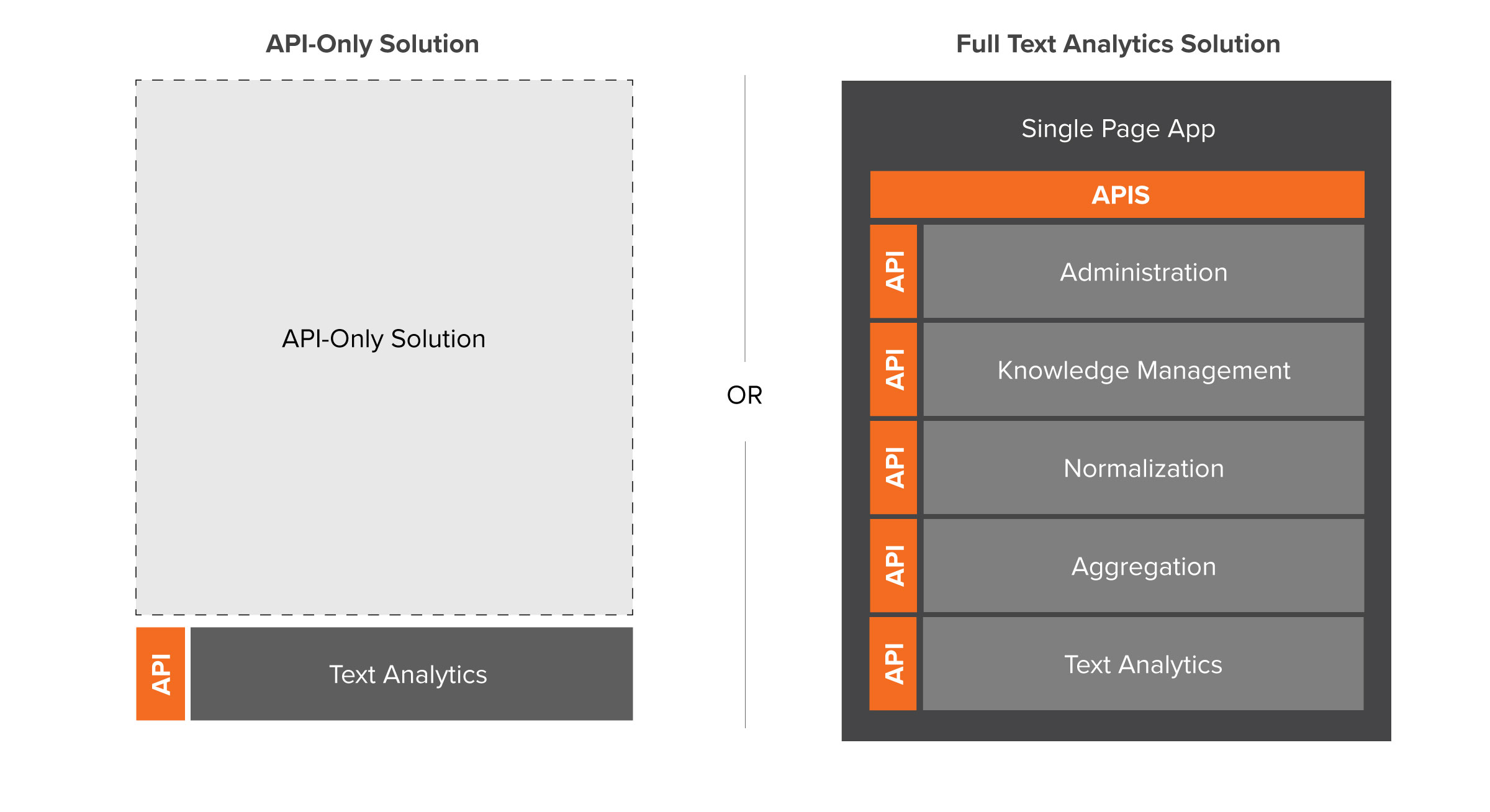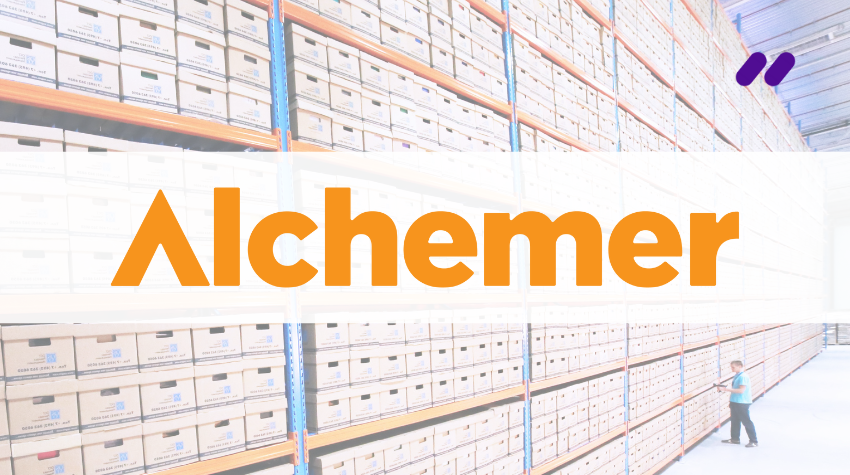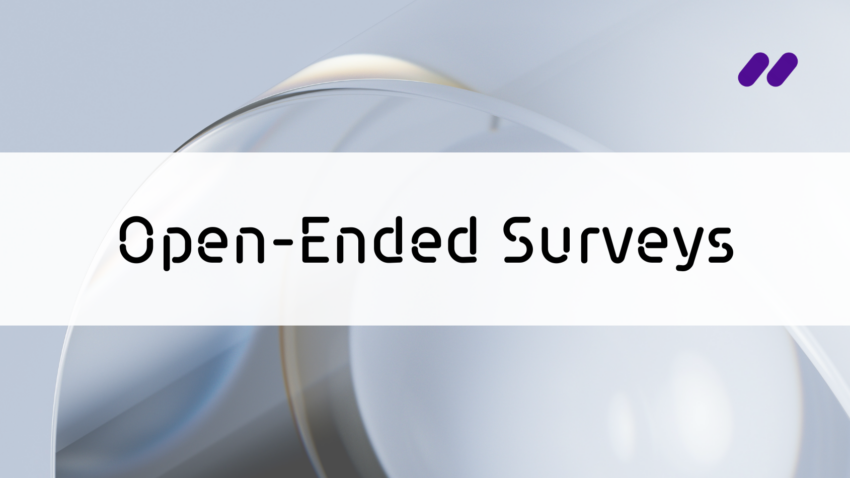Adding text analytics and sentiment analysis capabilities to your VOC or survey platform is no easy feat. That’s why we chose to work on a series of blog posts aimed at helping VoC providers strategically pick and purchase the right text analytics partner. In this final blog post of the series, we’ll look at different types of text analytics vendors and the factors you need to consider when comparing them. As a special bonus, we’ll leave you with a party favour of sorts; a downloadable, editable comparison chart that’ll help you navigate through your options and define the most relevant buying criteria for your company.
While every company in the text analytics space has it own, unique approach to identifying and extracting insight, there are three kinds of companies often found at the crossroads between text analytics and customer experience: customer experience platforms, API-only providers and full text analytics platforms.
1. Customer experience platforms: Industry-specific and difficult setup
As a VOC provider, you’re probably familiar with these vendors. Not only are their solutions well established in both the text analytics and the customer experience market, but there’s a high likelihood they’re your direct competitors.
In most cases, the leaders in this space use relatively rigid and rule-based keyword-based technology to extract context and meaning from unstructured data. This approach has a direct impact on accuracy; proving consistently good at recall, but not necessarily with precision or subtle nuances. Moreover, VoC providers are often surprised to find that once their CX platform has been implemented and set up, accuracy issues and blind sports become hard and labour-intensive to course correct.
Using a keyword-based solution means you’ll need to plan ample time and brainpower to set up each of your existing and potentially targeted client verticals.
In non-traditional verticals where customers don’t always express themselves in the ways documented in vendor-provided industry vertical libraries and augmented by your specifications, accuracy can be noticeably reduced. To get a sense of how well tailored the platform might be to your industry needs, we recommend asking vendors about their experience in your verticals before committing to a lengthy integration process.
Another element to consider with CX platforms is your data dashboard. Most text analytics users expect to see their data not categorized in buckets, but structured in an organic way reflective of the way customers usually express themselves. So unless you’ve set aside the time and resources to build your own, make sure you thoroughly evaluate whether results are presented
Additionally, using a keyword-based solution means you’ll need to plan ample time and brainpower to set up each of your existing and potentially targeted client verticals. To do so, the vendor will usually help you to define and configure the dimensions of your analysis while taking into account industry-specific terms, words and jargon related to your customers’ products or services. The entire cycle can take anywhere between 9 and 12 months to carry out. Moreover, you’ll need to ensure you meet the necessary infrastructure requirements to get started. If any of those requirements need to be added to your platform, you’ll need to budget for further time and costs.
Another element of resource allocation you’ll need to consider is training – which will be a prerequisite to anyone being able to use the platform, and is often offered at extra cost. The good news is, with built-in analysis tools and dashboards, trained users will usually find it quite easy to investigate results, identify insights and actions, and present their findings. You can also rest assured that most vendor agreements include an ongoing support contract, which allows you to request adjustments to your initial specifications. To avoid any surprises, you might want to request additional setups and feedback channels in your support contract.
2. API-only vendors: Limited functionalities, extra work required
While an API is simply a method of helping different softwares communicate with one another, it tends to connote something a little different in the text analytics industry. When vendors advertise text analytics or NLP APIs, they usually mean that they’re only providing a text analytics layer within a wider, more comprehensive text analytics solution. With this layer alone, initial functionality is typically reduced to just a few basic features like key topics, categories and tag clouds.
Here’s an example of a typical API-only solution vs. Keatext’s comprehensive stack (full text analytics solution):

If you choose to go with an API-only solution, you’ll likely need to internally build up the remaining layers for more advanced features and granular insights. Here’s an overview of the additional layers built into Keatext full stack solution in order to cover a higher level of use cases:
- Administration layer: Helps organizations manage users, access levels and keep track of their usage.
- Knowledge management layer: This layer has built-in logic that serves the right information to the user when they request it. Users can create custom categories and capture specific industry and company knowledge.
- Normalization layer: Nimbly interprets the data provided by the analytics layer, allowing it to detect changes such as trends, events or improvements over time. Depending on the technology used, this is where advanced features like word grouping and automatic metadata correlations become possible.
- Aggregation layer: Stores original metadata and analytics detected by the artificial intelligence pipeline for all of the documents. This means the user can perform advanced queries in a unified database across all of their datasets and communication channels, such as: “rising issues in the last week across all touch points”.
- Application: An application containing a user interface needs to be built on top of the technological solutions. For a wider user base, this shouldn’t require specialist knowledge such as coding.
At first sight these API-only text analytics solutions seem particularly attractive and advantageous because of their low cost-per-comment rate. That said, the human labour and costs associated with internally building a fully-fledged solution to support a standalone layer of text analytics can be extensive and dangerously hard to scope at the beginning of the project.
3. Full text analytics solutions: No blind spots, scalable
There has been a recent burst of innovation coming from small independent companies with close ties to the academic world. By leveraging the very latest research in NLP and AI, these next-generation text analytics providers have been able to move away from rigid keywords and rules in favour of more agile, iterative machine learning technologies. By maintaining such narrow ties with academia, full text analytics solutions are likelier to be built upon the most recent technology.
One of the biggest advantages of this kind of solution is that it’s less likely to leave you with blind spots. Rules and keywords-based solutions allow analysts to find what they’re looking for, but AI enables everyone – data expert or not – to find what they’re not looking for.
Rules and keywords-based solutions allow analysts to find what they’re looking for, but AI enables everyone – data expert or not – to find what they’re not looking for.
If your platform is also innovative and structure around industry best practices, you’re likely to integrate and implement these next-generation systems within a few days or a couple of weeks – depending on the complexity of the project.
As for the speed of data collation for a pure machine learning solution? It’s dramatically higher than competing solution categories. Once your initial system is implemented, you’ll be able to explore, analyze and segment your data efficiently and effectively by using the built-in analysis and visualization tools.
Full text analytics solutions are also much easier to scale. If, as with Keatext, there is no setup or configuration required, any increase in the volume of unstructured data from existing feedback sources is easily accommodated – as are new sources, products and markets.
If you’re looking to provide your clients with a self-service solution that allows for complete independence from costly data expertise, a full text analytics solution is likelier to supply a simple interface that makes it easy to interact with the results of the AI analysis, present findings, establish data-based recommendations and quickly share them with decision-makers.
4. Information is power
No matter which solution you decide is the best fit, we hope this series has given you the information and background you need to feel confident and clear-eyed in your final decision. With so many vendors vying for your attention, one of the biggest challenges has been fighting the market leaders to offer more transparency and visibility to the entire spectrum of text analytics solutions. So as you consider partnering with a text analytics provider, it’s important to do your due diligence. Here are a few questions to help your background check:
- Do they have established customers?
- Where are they getting their funding?
- Do they have solid academic credibility?
- Do they specialize in text analytics?
- Do they have experience working in your verticals?
- Will they be able to scale and grow with you throughout the years?
- What kind of support and collaboration can you expect from their team?
As promised, we’ve got a few extra resources to help with your buying journey. Click here to download the text analytics vendor comparison sheet.


